Seat Exeo 2008 Owner's manual
Manufacturer: SEAT, Model Year: 2008, Model line: Exeo, Model: Seat Exeo 2008Pages: 303, PDF Size: 10.02 MB
Page 131 of 303
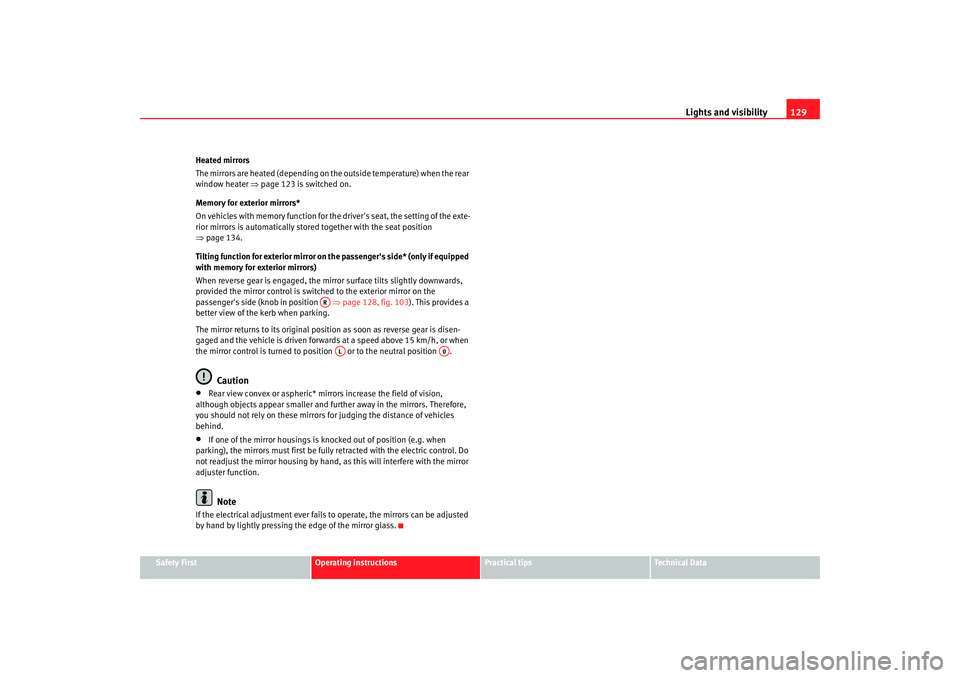
Lights and visibility129
Safety First
Operating instructions
Practical tips
Te c h n i c a l D a t a
Heated mirrors
The mirrors are heated (depending on th
e outside temperature) when the rear
window heater ⇒page 123 is switched on.
Memory for exterior mirrors*
On vehicles with memory function for the driver's seat, the setting of the exte-
rior mirrors is automatically stored together with the seat position
⇒ page 134.
Tilting function for exterior mirror on the passenger's side* (only if equipped
with memory for exterior mirrors)
When reverse gear is engaged, the mirror surface tilts slightly downwards,
provided the mirror control is switch ed to the exterior mirror on the
passenger's side (knob in position ⇒page 128, fig. 103 ). This provides a
better view of the kerb when parking.
The mirror returns to its original position as soon as reverse gear is disen-
gaged and the vehicle is driven forwards at a speed above 15 km/h, or when
the mirror control is turned to position or to the neutral position .
Caution
•
Rear view convex or aspheric* mirrors increase the field of vision,
although objects appear smaller and furt her away in the mirrors. Therefore,
you should not rely on these mirrors for judging the distance of vehicles
behind.
•
If one of the mirror housings is knocked out of position (e.g. when
parking), the mirrors must first be fully retracted with the electric control. Do
not readjust the mirror housing by hand, as this will interfere with the mirror
adjuster function.Note
If the electrical adjustment ever fails to operate, the mirrors can be adjusted
by hand by lightly pressing the edge of the mirror glass.
AR
AL
A0
Exeo_EN.book Seite 129 Freitag, 17. Oktober 2008 11:24 11
Page 132 of 303
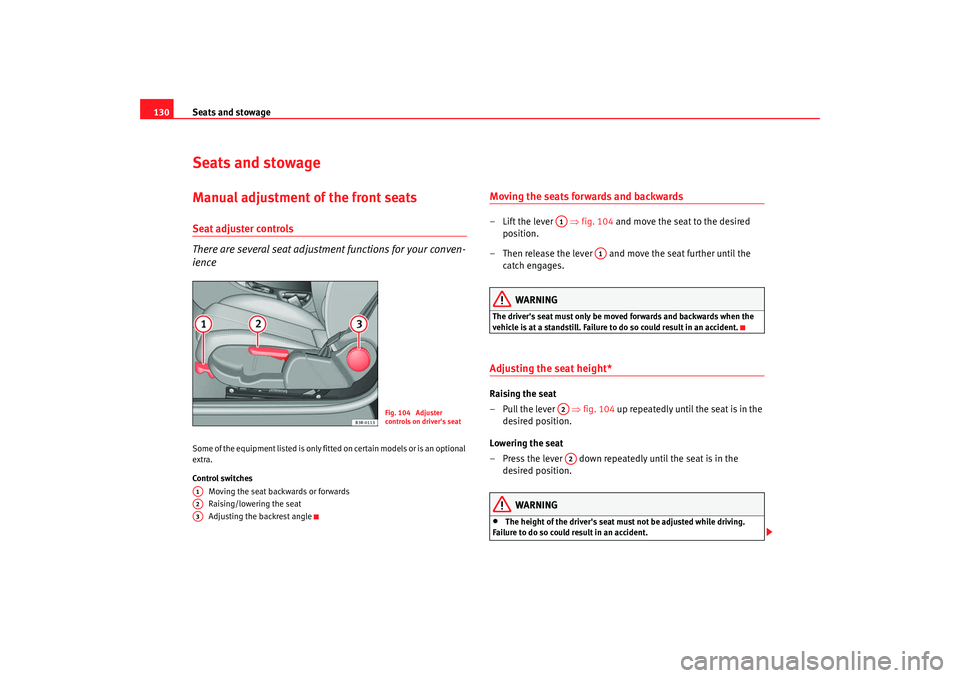
Seats and stowage
130Seats and stowageManual adjustment of the front seatsSeat adjuster controls
There are several seat adjustment functions for your conven-
ienceSome of the equipment listed is only fitt ed on certain models or is an optional
extra.
Control switches
Moving the seat backwards or forwards
Raising/lowering the seat
Adjusting the backrest angle
Moving the seats forwards and backwards– Lift the lever ⇒fig. 104 and move the seat to the desired
position.
– Then release the lever and move the seat further until the catch engages.
WARNING
The driver's seat must only be moved forwards and backwards when the
vehicle is at a standstill. Failure to do so could result in an accident.Adjusting the seat height*Raising the seat
–Pull the lever ⇒ fig. 104 up repeatedly until the seat is in the
desired position.
Lowering the seat
– Press the lever down repeatedly until the seat is in the desired position.
WARNING
•
The height of the driver's seat must not be adjusted while driving.
Failure to do so could result in an accident.
Fig. 104 Adjuster
controls on driver's seat
A1A2A3
A1
A1
A2A2
Exeo_EN.book Seite 130 Freitag, 17. Oktober 2008 11:24 11
Page 133 of 303
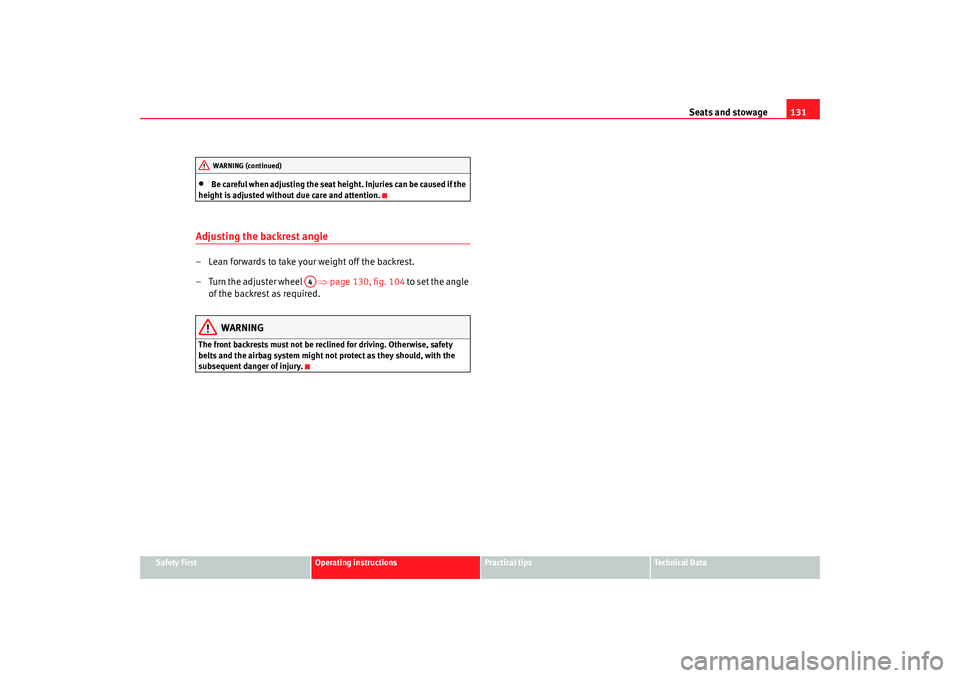
Seats and stowage131
Safety First
Operating instructions
Practical tips
Te c h n i c a l D a t a
•
Be careful when adjusting the seat he ight. Injuries can be caused if the
height is adjusted without due care and attention.
Adjusting the backrest angle– Lean forwards to take your weight off the backrest.
– Turn the adjuster wheel ⇒page 130, fig. 104 to set the angle
of the backrest as required.
WARNING
The front backrests must not be reclined for driving. Otherwise, safety
belts and the airbag system might no t protect as they should, with the
subsequent danger of injury.
WARNING (continued)
A4
Exeo_EN.book Seite 131 Freitag, 17. Oktober 2008 11:24 11
Page 134 of 303
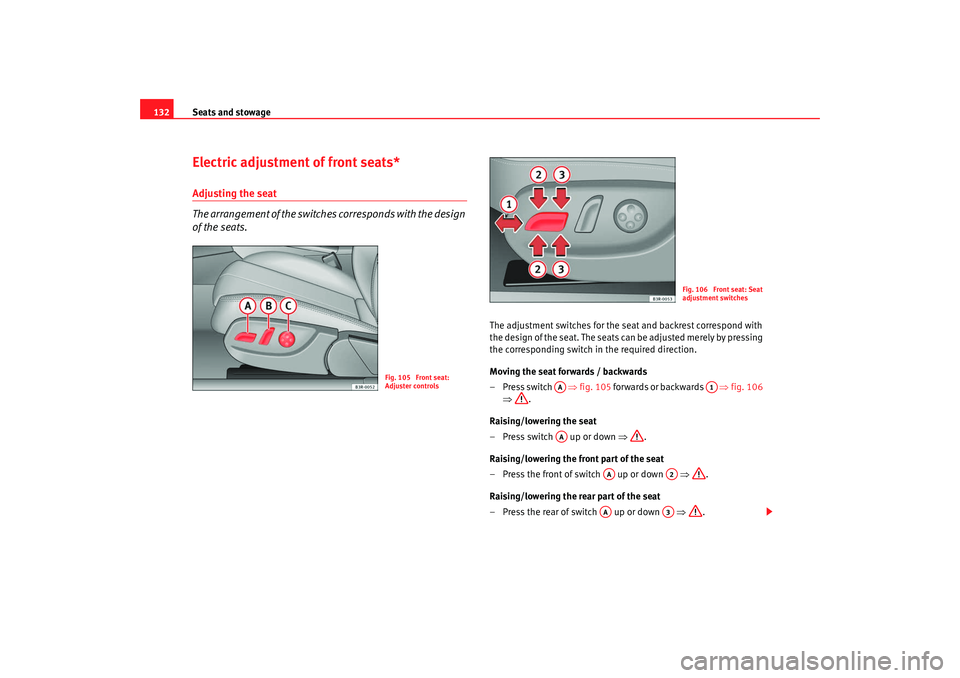
Seats and stowage
132Electric adjustment of front seats*Adjusting the seat
The arrangement of the switches corresponds with the design
of the seats.
The adjustment switches for the seat and backrest correspond with
the design of the seat. The seats can be adjusted merely by pressing
the corresponding switch in the required direction.
Moving the seat forwards / backwards
–Press switch ⇒fig. 105 forwards or backwards ⇒fig. 106
⇒ .
Raising/lowering the seat
– Press switch up or down ⇒.
Raising/lowering the front part of the seat
– Press the front of switch up or down ⇒.
Raising/lowering the rear part of the seat
– Press the rear of switch up or down ⇒.
Fig. 105 Front seat:
Adjuster controls
Fig. 106 Front seat: Seat
adjustment switches
AA
A1
AA
AA
A2
AA
A3
Exeo_EN.book Seite 132 Freitag, 17. Oktober 2008 11:24 11
Page 135 of 303
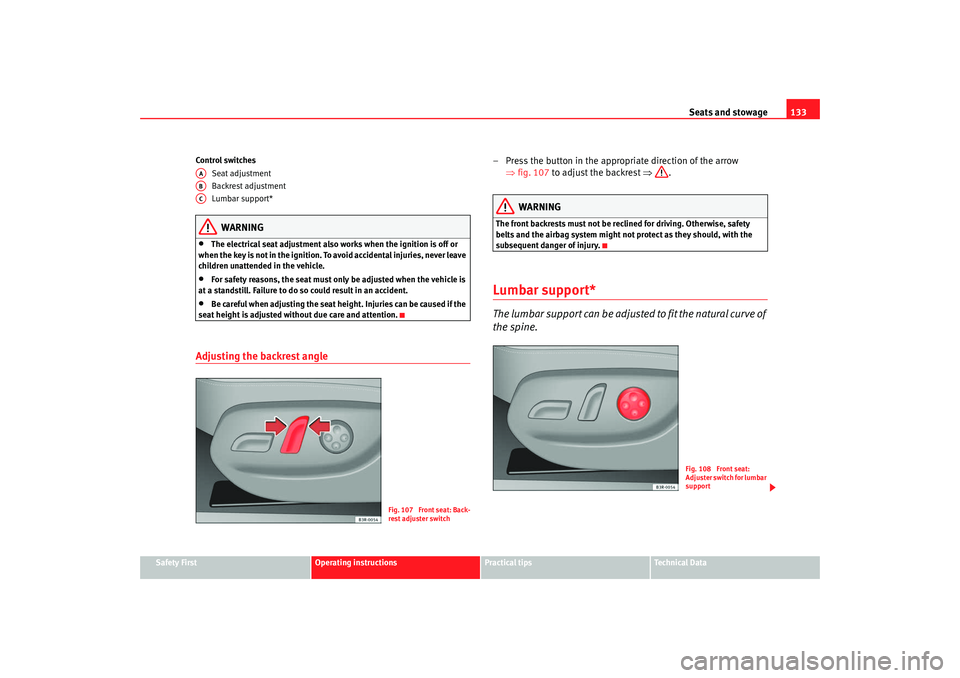
Seats and stowage133
Safety First
Operating instructions
Practical tips
Te c h n i c a l D a t a
Control switches
Seat adjustment
Backrest adjustment
Lumbar support*
WARNING
•
The electrical seat adjustment also works when the ignition is off or
when the key is not in th e ignition. To avoid accidental injuries, never leave
children unattended in the vehicle.
•
For safety reasons, the seat must on ly be adjusted when the vehicle is
at a standstill. Failure to do so could result in an accident.
•
Be careful when adjusting the seat h eight. Injuries can be caused if the
seat height is adjusted with out due care and attention.
Adjusting the backrest angle
– Press the button in the appropriate direction of the arrow
⇒fig. 107 to adjust the backrest ⇒.
WARNING
The front backrests must not be reclin ed for driving. Otherwise, safety
belts and the airbag system might no t protect as they should, with the
subsequent danger of injury.Lumbar support*The lumbar support can be adjust ed to fit the natural curve of
the spine.
AAABAC
Fig. 107 Front seat: Back-
rest adjuster switch
Fig. 108 Front seat:
Adjuster switch for lumbar
support
Exeo_EN.book Seite 133 Freitag, 17. Oktober 2008 11:24 11
Page 136 of 303
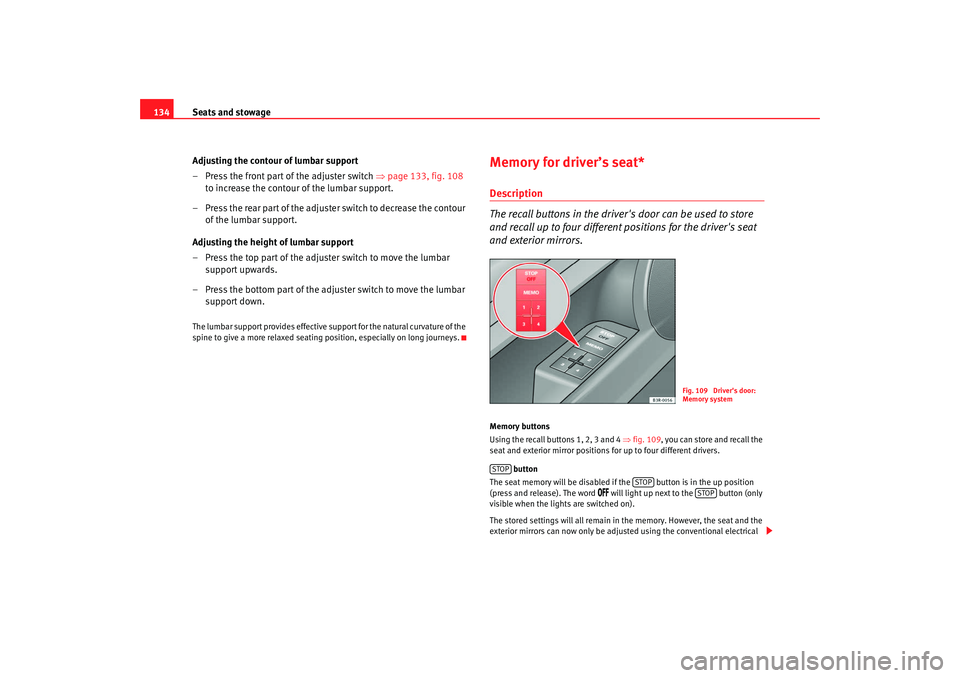
Seats and stowage
134
Adjusting the contour of lumbar support
– Press the front part of the adjuster switch ⇒page 133, fig. 108
to increase the contour of the lumbar support.
– Press the rear part of the adjuster switch to decrease the contour of the lumbar support.
Adjusting the height of lumbar support
– Press the top part of the adjuster switch to move the lumbar support upwards.
– Press the bottom part of the adjuster switch to move the lumbar support down.The lumbar support provides effective su pport for the natural curvature of the
spine to give a more relaxed seating position, especially on long journeys.
Memory for driver’s seat*Description
The recall buttons in the driver's door can be used to store
and recall up to four different positions for the driver's seat
and exterior mirrors.Memory buttons
Using the recall buttons 1, 2, 3 and 4 ⇒fig. 109 , you can store and recall the
seat and exterior mirror positions for up to four different drivers.
button
The seat memory will be disabled if the button is in the up position
(press and release). The word
will light up next to the button (only
visible when the lights are switched on).
The stored settings will all remain in the memory. However, the seat and the
exterior mirrors can now only be adjust ed using the conventional electrical
Fig. 109 Driver's door:
Memory system
STOP
STOP
STOP
Exeo_EN.book Seite 134 Freitag, 17. Oktober 2008 11:24 11
Page 137 of 303
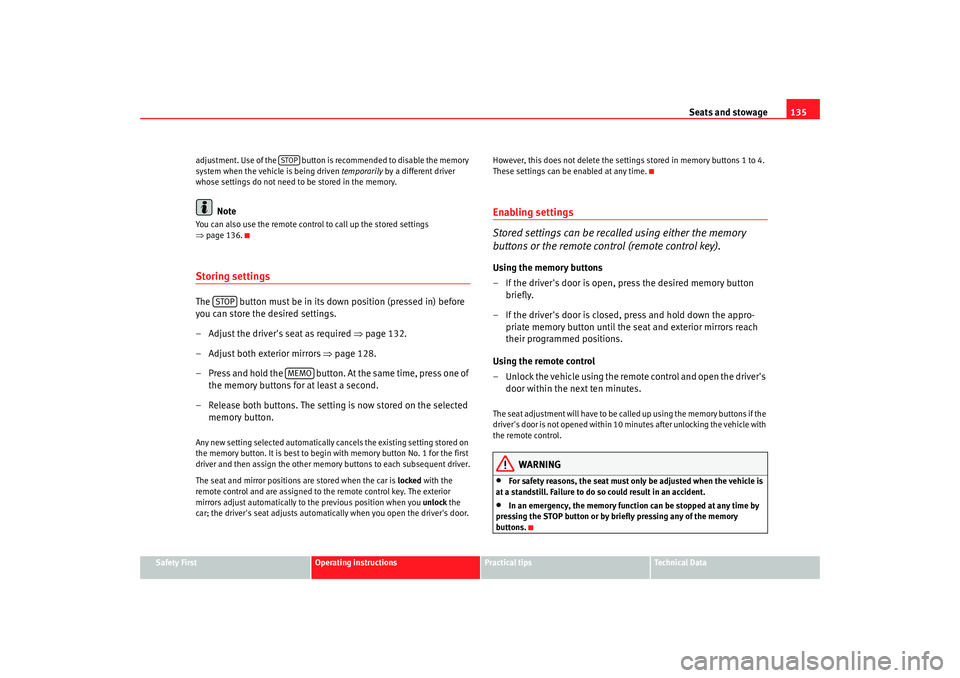
Seats and stowage135
Safety First
Operating instructions
Practical tips
Te c h n i c a l D a t a
adjustment. Use of the button is
recommended to disable the memory
system when the vehicle is being driven temporarily by a different driver
whose settings do not need to be stored in the memory.
Note
You can also use the remote control to call up the stored settings
⇒ page 136.Storing settingsThe button must be in its down position (pressed in) before
you can store the desired settings.
– Adjust the driver's seat as required ⇒page 132.
– Adjust both exterior mirrors ⇒page 128.
– Press and hold the button. At the same time, press one of
the memory buttons fo r at least a second.
– Release both buttons. The setting is now stored on the selected memory button.Any new setting selected automatically cancels the existing setting stored on
the memory button. It is best to begi n with memory button No. 1 for the first
driver and then assign the other memory buttons to each subsequent driver.
The seat and mirror positions are stored when the car is locked with the
remote control and are assigned to th e remote control key. The exterior
mirrors adjust automatically to the previous position when you unlock the
car; the driver's seat adjusts automatically when you open the driver's door. However, this does not delete the settings stored in memory buttons 1 to 4.
These settings can be enabled at any time.
Enabling settings
Stored settings can be recalled using either the memory
buttons or the remote control (remote control key).Using the memory buttons
– If the driver's door is open, press the desired memory button
briefly.
– If the driver's door is closed, press and hold down the appro- priate memory button until the seat and exterior mirrors reach
their programmed positions.
Using the remote control
– Unlock the vehicle using the remote control and open the driver's door within the next ten minutes.The seat adjustment will have to be called up using the memory buttons if the
driver's door is not opened within 10 minutes after unlocking the vehicle with
the remote control.
WARNING
•
For safety reasons, the seat must only be adjusted when the vehicle is
at a standstill. Failure to do so could result in an accident.
•
In an emergency, the memory function can be stopped at any time by
pressing the STOP button or by briefly pressing any of the memory
buttons.
STOP
STOP
MEMO
Exeo_EN.book Seite 135 Freitag, 17. Oktober 2008 11:24 11
Page 138 of 303
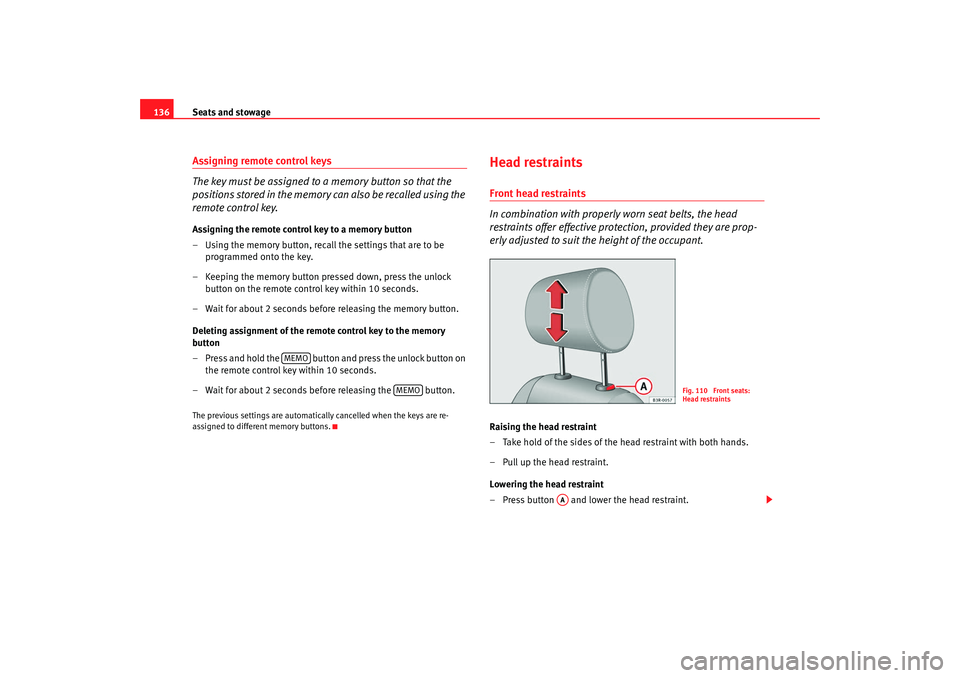
Seats and stowage
136Assigning remote control keys
The key must be assigned to a memory button so that the
p o s i t i o ns st o red i n t h e m e m o r y ca n al s o b e recall ed u s i ng t h e
remote control key.Assigning the remote control key to a memory button
– Using the memory button, recall the settings that are to be
programmed onto the key.
– Keeping the memory button pressed down, press the unlock button on the remote control key within 10 seconds.
– Wait for about 2 seconds before releasing the memory button.
Deleting assignment of the remote control key to the memory
button
– Press and hold the button and press the unlock button on the remote control key within 10 seconds.
– Wait for about 2 seconds befo re releasing the button.The previous settings are automatically cancelled when the keys are re-
assigned to different memory buttons.
Head restraintsFront head restraints
In combination with properly worn seat belts, the head
restraints offer effective protection, provided they are prop-
erly adjusted to suit the height of the occupant.Raising the head restraint
– Take hold of the sides of the head restraint with both hands.
–Pull up the head restraint.
Lowering the head restraint
– Press button and lower the head restraint.
MEMO
MEMO
Fig. 110 Front seats:
Head restraints
AA
Exeo_EN.book Seite 136 Freitag, 17. Oktober 2008 11:24 11
Page 139 of 303
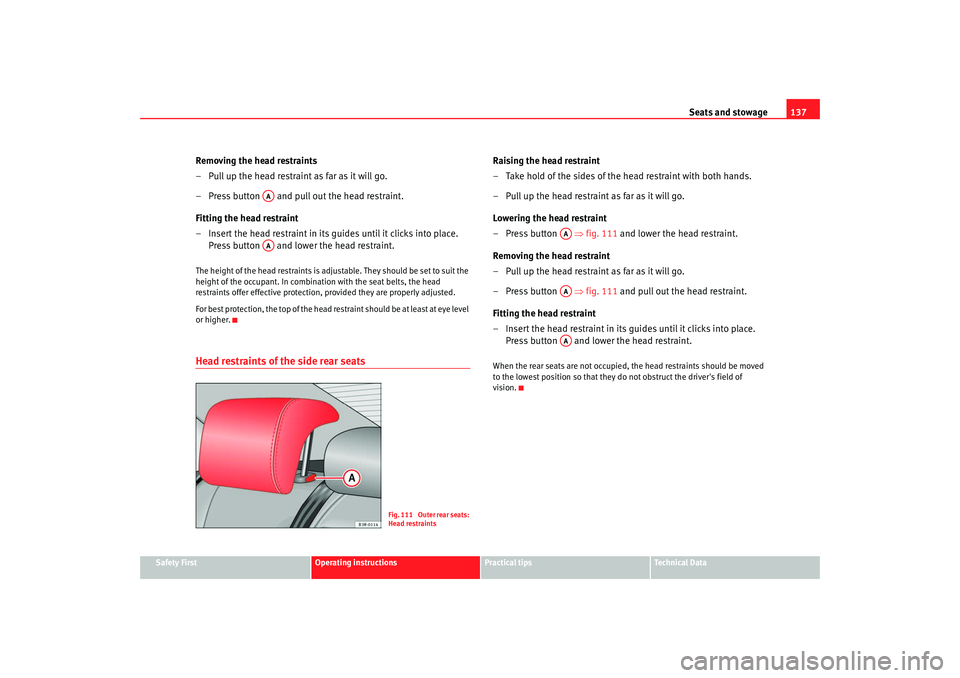
Seats and stowage137
Safety First
Operating instructions
Practical tips
Te c h n i c a l D a t a
Removing the head restraints
– Pull up the head restraint as far as it will go.
– Press button and pull out the head restraint.
Fitting the head restraint
– Insert the head restraint in its guides until it clicks into place.
Press button and lower the head restraint.The height of the head restraints is ad justable. They should be set to suit the
height of the occupant. In combination with the seat belts, the head
restraints offer effective protection, provided they are properly adjusted.
For best protection, the top of the head restraint should be at least at eye level
or higher.Head restraints of the side rear seats
Raising the head restraint
– Take hold of the sides of the head restraint with both hands.
– Pull up the head restraint as far as it will go.
Lowering the head restraint
– Press button ⇒ fig. 111 and lower the head restraint.
Removing the head restraint
– Pull up the head restraint as far as it will go.
– Press button ⇒ fig. 111 and pull out the head restraint.
Fitting the head restraint
– Insert the head restraint in its guides until it clicks into place. Press button and lower the head restraint.When the rear seats are not occupied, the head restraints should be moved
to the lowest position so that they do not obstruct the driver's field of
vision.
AAAA
Fig. 111 Outer rear seats:
Head restraints
AAAAAA
Exeo_EN.book Seite 137 Freitag, 17. Oktober 2008 11:24 11
Page 140 of 303
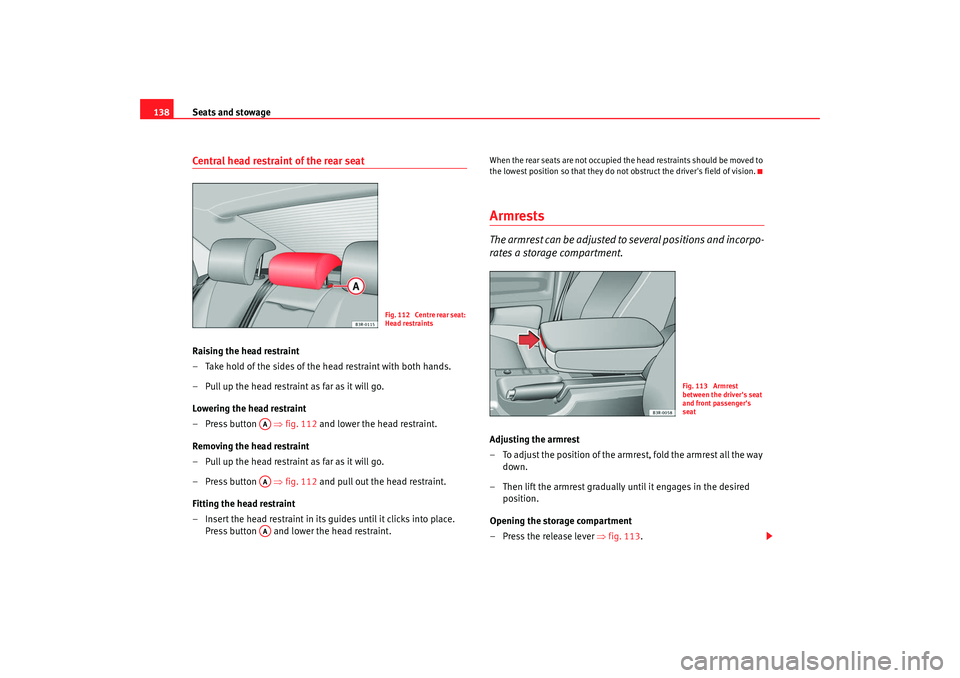
Seats and stowage
138Central head restraint of the rear seatRaising the head restraint
– Take hold of the sides of the head restraint with both hands.
– Pull up the head restraint as far as it will go.
Lowering the head restraint
– Press button ⇒fig. 112 and lower the head restraint.
Removing the head restraint
– Pull up the head restraint as far as it will go.
– Press button ⇒fig. 112 and pull out the head restraint.
Fitting the head restraint
– Insert the head restraint in its guides until it clicks into place. Press button and lower the head restraint.
When the rear seats are not occupied the head restraints should be moved to
the lowest position so that they do not obstruct the driver's field of vision.ArmrestsThe armrest can be adjusted to several positions and incorpo-
rates a storage compartment.Adjusting the armrest
– To adjust the position of the armr est, fold the armrest all the way
down.
– Then lift the armrest gradually until it engages in the desired
position.
Opening the storage compartment
– Press the release lever ⇒fig. 113 .
Fig. 112 Centre rear seat:
Head restraints
AAAAAA
Fig. 113 Armrest
between the driver's seat
and front passenger's
seat
Exeo_EN.book Seite 138 Freitag, 17. Oktober 2008 11:24 11